Curious whether you can take blankets on airplanes or keep the airplane blanket as a souvenir? The experts explain which onboard amenities you can keep and which you must leave behind.
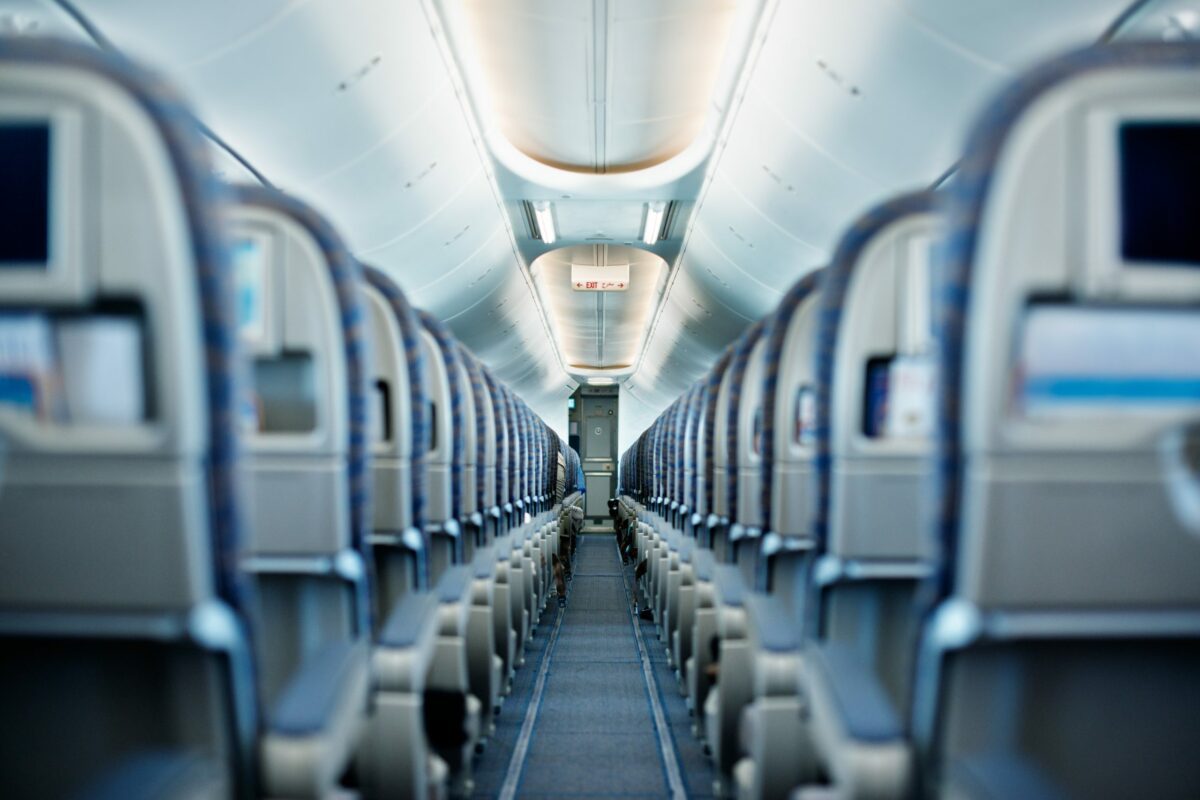
6 Things You Can Take from Planes—And 5 Things You Can’t

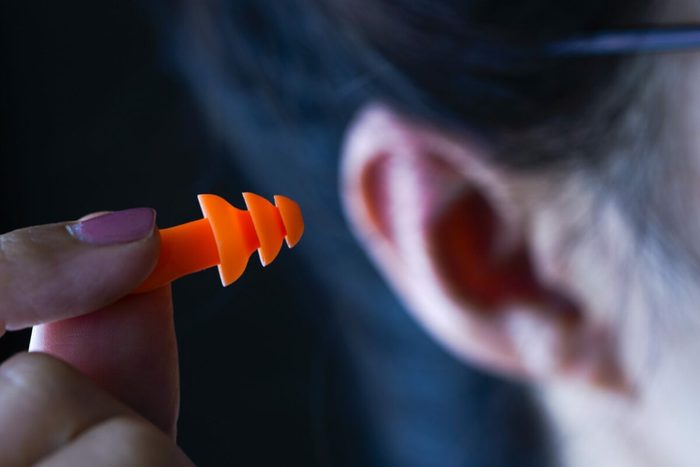
What you can take: Amenity kits
If the airline provides an individual amenity kit, it’s all yours. These kits are typically offered to passengers in first or business class, and sometimes to economy passengers on long-haul flights, depending on the airline. They contain personal care and comfort items such as a toothbrush, toothpaste, moisturizer, an eye mask and earplugs. Some airlines, including Hawaiian Airlines, are putting more thought into these kits—collaborating with Native Hawaiian designers, offering Hawaii-made products and utilizing responsibly sourced materials. I certainly appreciated the lip balm and hydrating facial mist on a 10-hour flight from Hawaii to Australia. And even if you don’t use the amenity kit on board, you can take it to repurpose it as a makeup pouch or eco-friendly gift bag.

What you can take: Sanitizing gel and wipes
Many airlines, such as United Airlines, distribute sanitizing wipes or gel during boarding. The airlines won’t reuse them once they’ve landed in your hands. So, while it’s advisable to wipe down high-touch surfaces such as your seatbelt and tray table with the complimentary sanitizing wipes or gels, you’re also welcome to tuck them away for later use at home or in your travels.
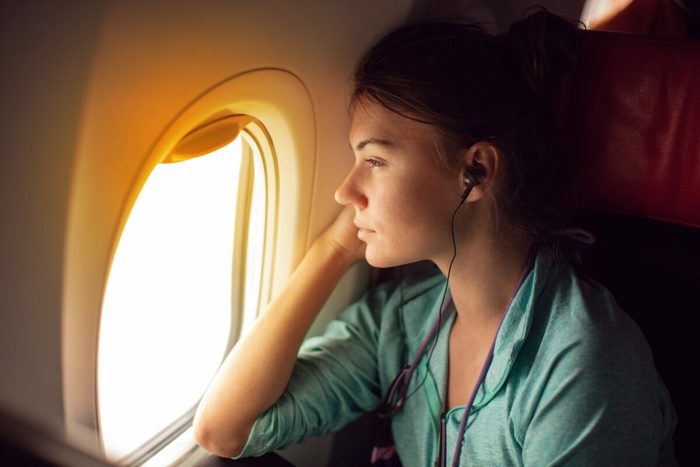
What you can (sometimes) take: Headsets
Most major airlines, including Delta Air Lines, American Airlines and United Airlines, have headsets available on request for flights that offer complimentary entertainment. (First and business-class headsets are a separate issue that we’ll get to below.) However, whether you can take them with you is up to the airline. Some, such as Delta, discard economy-class headsets after use, so you’re welcome to take and use them on future flights. Other airlines, like Emirates, collect them at the end of the flight and then send them to MNH Sustainable Cabin Services to be cleaned and serviced for reuse. If you want to keep the airline headset, ask your flight attendant what their policy is.
Personally, I try to use my own headset or earbuds whenever possible to avoid contributing to single-use plastic waste.
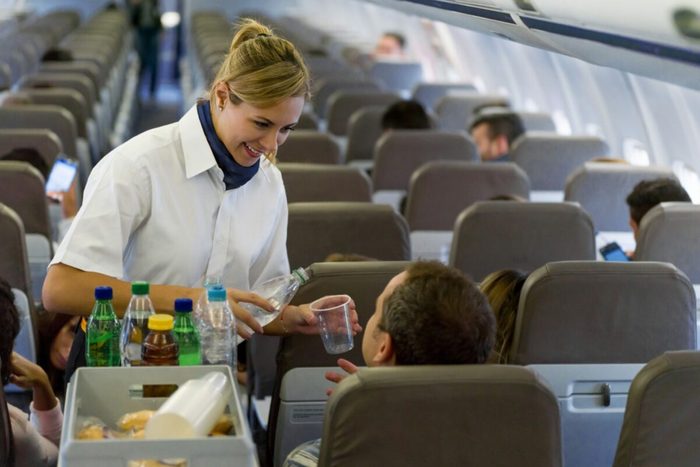
What you can (sometimes) take: Leftover food
Altwal says it’s perfectly fine on some airlines, like Royal Jordanian, for passengers to take their leftovers to their layover or next destination. But this is not the case for every airline and every destination. “Domestically, passengers on United flights can take the snacks or food we serve,” Kelley says, “but not internationally.” Double-check with your flight attendant before landing.
You must also be mindful of agricultural regulations at your destination. I’m always careful about not bringing fresh fruit when flying into Hawaii, for example, where agriculture items must be declared and inspected on arrival. But I was once stopped in the customs hall at LAX by a member of the “Beagle Brigade,” the agriculture canine team that sniffs out plant and animal products. The cause for all the commotion? A single, seemingly innocent banana in my carry-on bag. It was served on my international flight and I’d forgotten about it in my jet-lagged state. After the Beagle Brigade busted me, I wasn’t allowed to simply throw the banana out; I was instructed to wait in line for it to be officially collected and destroyed. That little leftover caused a big scene, and was definitely not worth the delay!
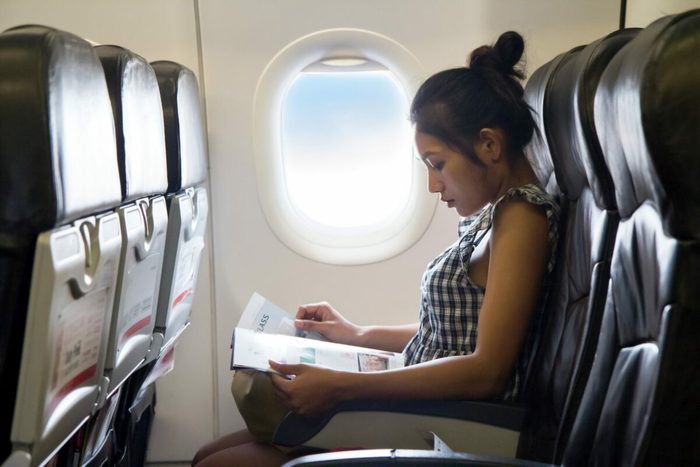
What you can take: Inflight magazine
Another onboard item you’re allowed to take is the inflight magazine—that is if you can even find one. Many airlines, especially in the U.S., have done away with them. As a frequent traveler and travel writer, I loved reading and collecting inflight magazines. It was always nice to grab a complimentary copy to share with my parents or a friend, especially when my travel writing appeared in them. Thankfully, Hawaiian Airlines still publishes its magazine, Hana Hou!, and a rep I spoke with confirmed that passengers can take the magazine as a souvenir—in fact, the airline encourages it.
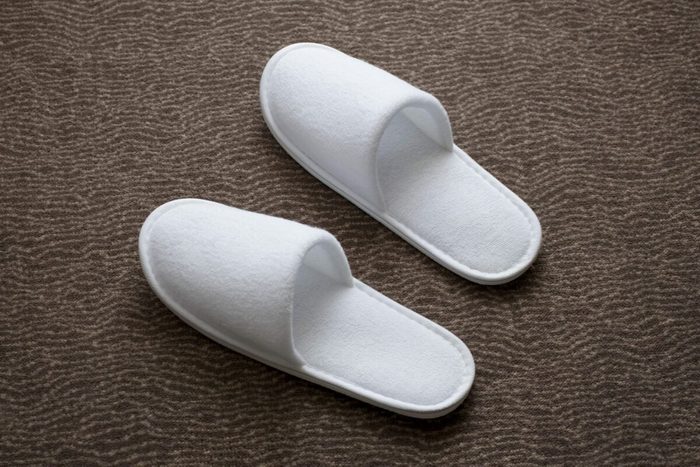
What you can take: Sleepwear & slippers
If you’re traveling in a premium cabin and receive a sleepwear set and slippers, they’re yours for the taking. Airlines can’t reuse them, so Westacott says you’re welcome to tuck them in your bag before landing and bring them home as a keepsake.

What you can’t take: Entertainment tablets and premium headsets
Another perk of traveling in first or business class is better quality headsets and sometimes individual entertainment tablets. The experts say that flight attendants distribute these to business class travelers for use during the flight, but these items must be left on board. And don’t even think about trying to sneak one out; the flight attendants count them so they will notice if one goes missing.

What you can’t take: Beverages
Flight attendants usually collect cups and unfinished drinks before landing, so you aren’t likely to have any left. But just in case, here are some general rules about beverages:
-
Alcohol. Unfinished alcoholic drinks should not be taken off the plane. Also worth noting: While you can bring alcohol in your carry-on in small amounts that don’t exceed the TSA liquid limit, FAA regulations permit passengers to drink alcohol on board only if it’s served by the flight attendants (and if they determine you are not too intoxicated).
-
Water. Don’t take entire bottles of water from the catering cart or galley—during the flight or upon landing. Altwal says that each flight is allotted a certain number of bottles to serve all passengers, so it’s important not to remove them. If you need water, you can always ask.
-
Other soft beverages. If you’ve purchased or been given a non-alcoholic beverage on board, it may be okay to take them off some flights. However, cups and cans are usually collected as part of landing preparation so they shouldn’t be in your possession anyway.
Overall, I’d say bottoms up before wheels down seems like the best approach!

What you can’t take: Blankets, pillows and other bedding
If you’re wondering whether you can keep airplane blankets, the answer is no. “Most complimentary items available inflight are intended for customer comfort to ensure they have the most relaxing journey possible,” Westacott says. “But these items should not be removed from the aircraft, and we kindly request that guests leave them behind for our teams to clean and repurpose [for future flights].”
So, what happens if you take a blanket from an airplane? Although you’re probably not going to get tackled on the jet bridge (or sniffed out by the Beagle Brigade!), you are stealing, and it costs the airline money to replace stolen items. “They are the company’s property and should not be taken by passengers,” Altwal says.
If you prefer to bring your own, you may be curious about whether you can take blankets on airplanes. Kelley says passengers can generally bring their own blanket and pillow on board. And the even better news? These items do not count as your carry-on.

What you can’t take: Bathroom products
There’s little allure to the standard bathroom soaps and lotions found in economy class. But, in the event you are tempted to take them, please consider your fellow passengers (and all the germs they’ll be spreading without that soap you popped into your purse). Westacott confirms that bathroom products intended for general use should not be removed.
The exception would be individual toiletries offered in the first-class shower suites you might find on a handful of long-haul airplanes.
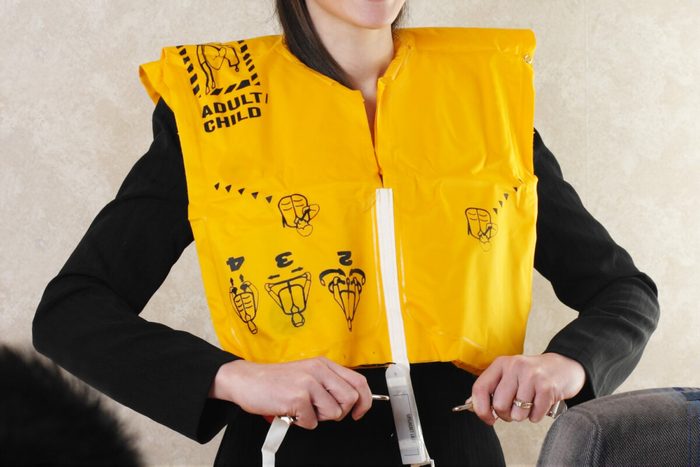
What you can’t take: Safety and operational equipment
You might think a safety card or life vest makes for a quirky souvenir. But the airline and authorities won’t find it funny if you remove them from the airplane. “Safety and operational items such as safety cards, safety equipment, menus, first aid items and life jackets should remain onboard as they’re important to the aircraft’s operation or subject to international regulations,” Westacott says.
Removing safety and operational equipment is illegal and can cause flight delays. Altwal explains that a Minimum Equipment List (MEL) outlines the items and quantity required to operate each aircraft without compromising safety. “Some items are so important that we call them ‘no-go’ items,” she says. The airplane cannot leave the ground if they are missing. “So, imagine if a passenger takes even one no-go item, such as a fire extinguisher. The aircraft won’t leave the ground until another fire extinguisher is brought on board.” And if this happens while a plane is at an outstation (an airport that is not the airline’s hub or base), Altwal says it complicates things further. Retrieving a new MEL item depends on the agreement between the airline and the destination, so replacing it can cause longer delays.
Safety and operational equipment also tend to be costly to replace. For example, the small and seemingly simple tool used on the Airbus 320 to manually release oxygen masks (if they don’t automatically release in an emergency) costs over $100.
Ultimately, if you’re ever wondering whether an item can be removed from an airplane and you can’t find a clear answer, it’s best to ask a flight attendant. Or simply err on the side of caution and do as Kelley suggests: Just don’t take anything off an airplane that isn’t yours.
About the experts
|
Why trust us
Reader’s Digest has published hundreds of travel stories that help readers explore the world safely, easily and affordably. We regularly cover topics such as the best places to visit (and the best times to visit them), tips and tricks to zoom through airport security, flight-attendant secrets, hotel-room hacks and more. We’re committed to producing high-quality content by writers with expertise and experience in their field in consultation with relevant, qualified experts. We rely on reputable primary sources, including government and professional organizations and academic institutions as well as our writers’ personal experiences where appropriate. We verify all facts and data, back them with credible sourcing and revisit them over time to ensure they remain accurate and up to date. For this piece, Sunny Fitzgerald tapped her experience as a longtime travel writer and frequent traveler to ensure that all information is accurate and offers the best possible advice to readers. Read more about our team, our contributors and our editorial policies.
Sources:
- Suzan Altwal, a bilingual Royal Jordanian Airlines flight attendant with 10 years of experience, including long-haul flights between the U.S. and Jordan, interviewed March 2025
- Deep Westacott, a former flight attendant and the current regional engagement, development and performance manager for Cathay Pacific, interviewed March 2025
- Julie Kelley, a frequent traveler and a United Airlines flight attendant with 45 years of domestic and international service, interviewed March 2025
- Noho Home: “From Hawaiian skies to your home, introducing Leihōkū: Hawaiian Airlines collaboration”
- Hawaiian Airlines: “Hawaiian Airlines to debut new amenity kits and soft goods by Hawai`i lifestyle brand Noho Home”
- MNH Sustainable Cabin Services: Emirates Airlines
- United Airlines: “What to expect when you fly”
- State of Hawaii Plant Industry Division: “Traveling and Shipping from the U.S. Mainland to Hawai’i”
- U.S. Customs and Border Protection: “Agriculture Canine”
- Hawaiian Airlines: Hana Hou!
- Transportation Security Administration: “Alcoholic beverages”
- Delta Airlines: “Onboard experience”




















